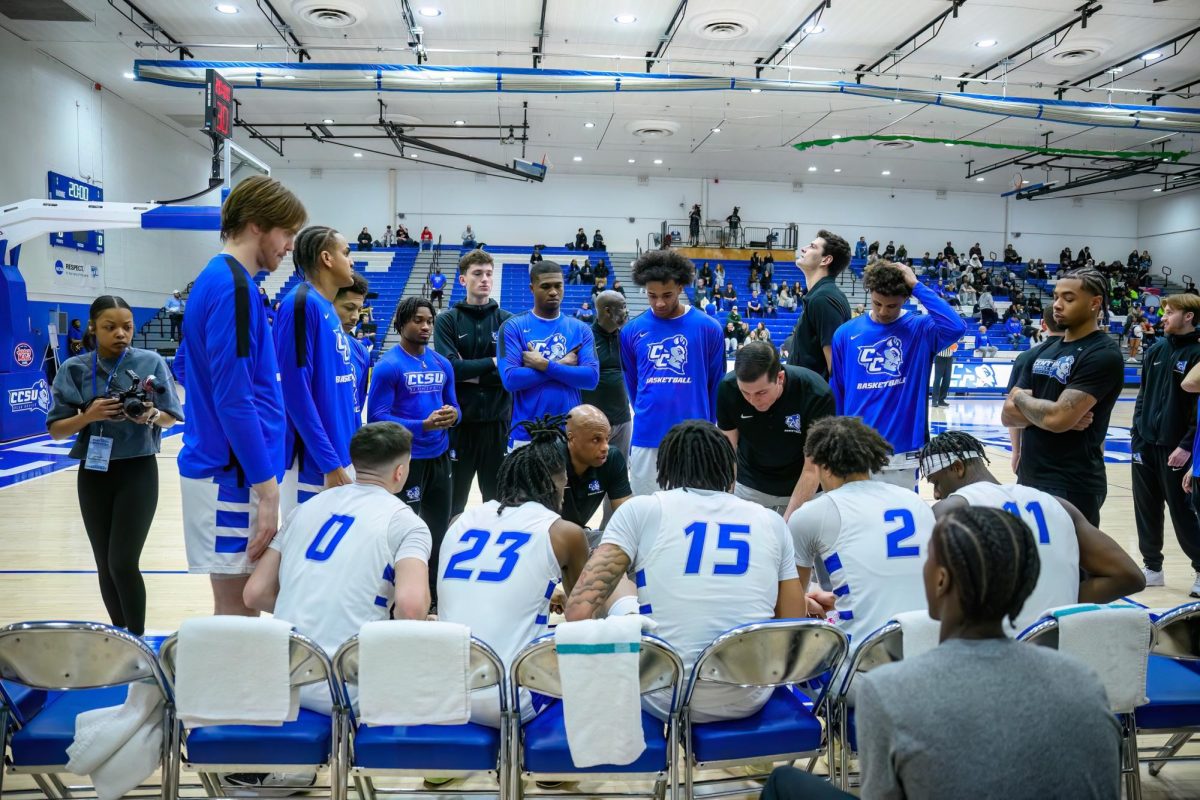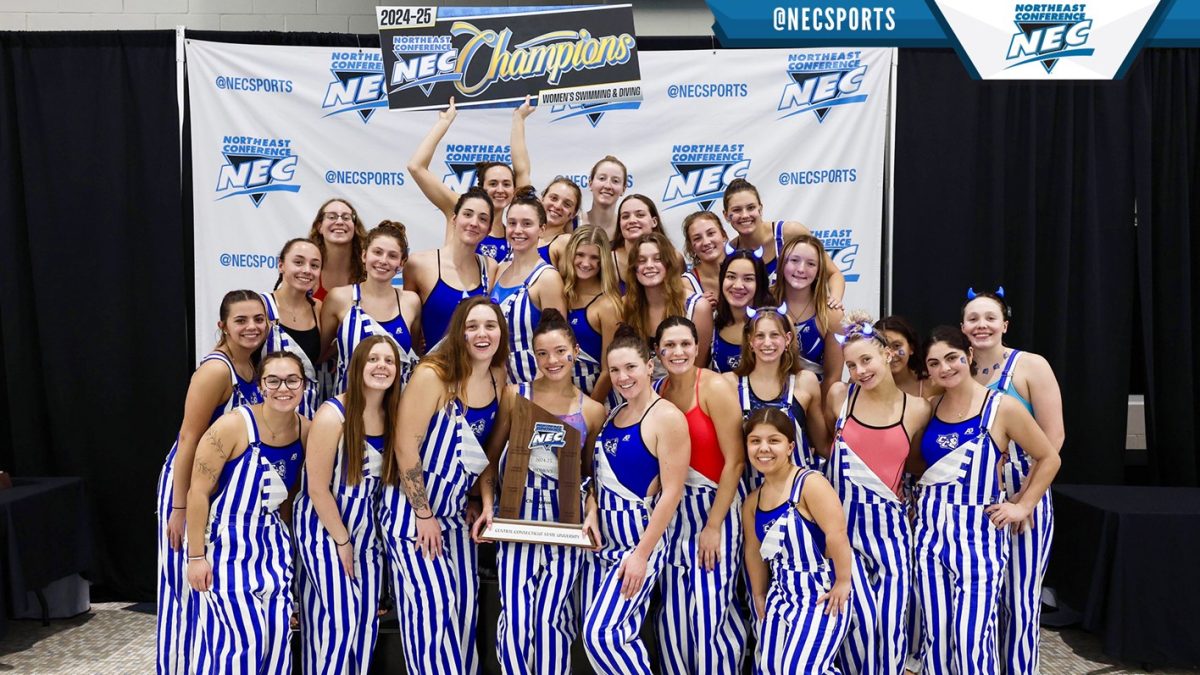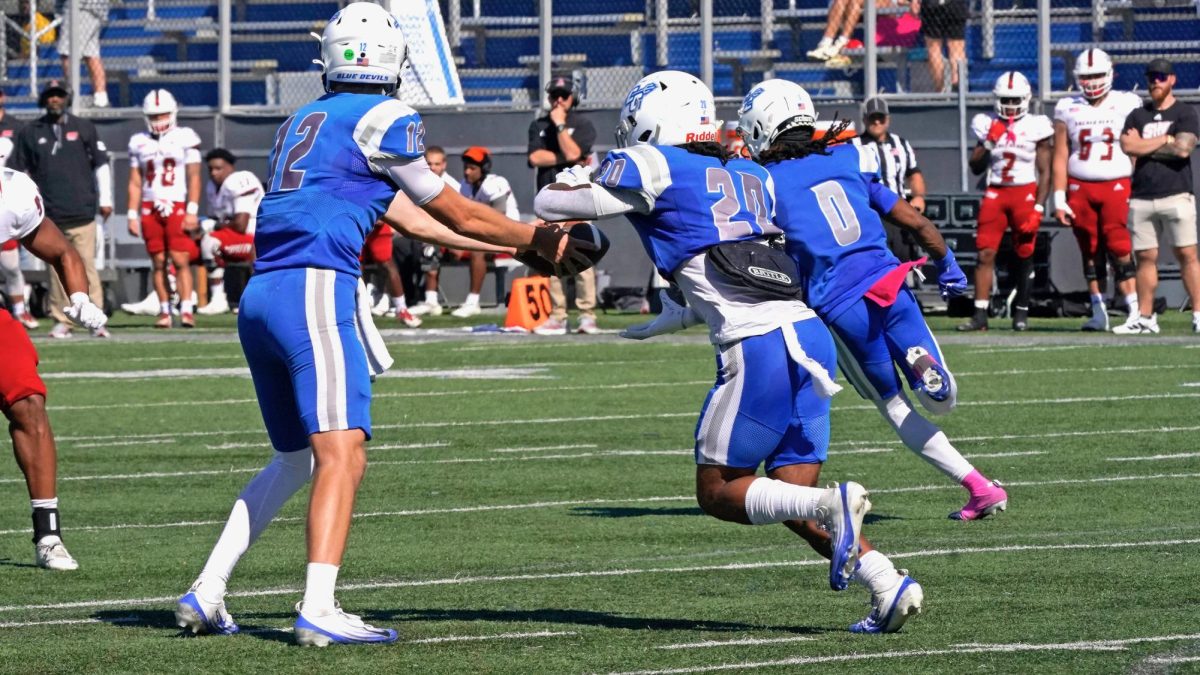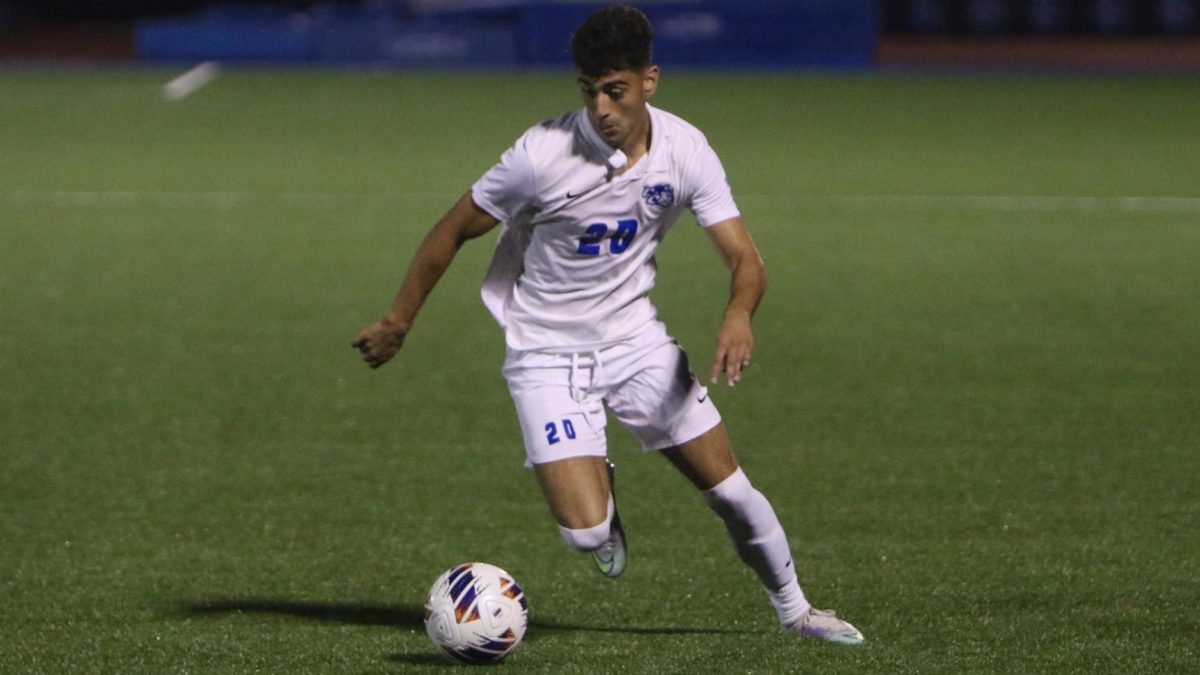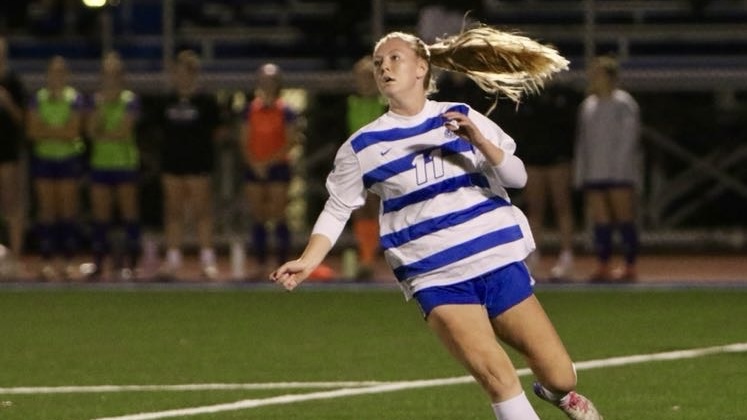With seven seconds remaining in Central Connecticut State’s Northeast Conference semifinal game against Fairleigh Dickinson University, and the Blue Devils clinging on to a two-point lead, Jordan Jones made Central’s biggest play in 18 years.
FDU star Terrence Brown had the ball with the chance to tie or take the lead and decided to pass, but Jones anticipated the play and swooped in for a steal. Jones got fouled with 4.6 seconds remaining and immediately raised his hands to hype up the home crowd. He stepped up to the free-throw line and calmly knocked down two free throws to seal the game and send CCSU to the NEC Championship for the first time since 2007.
While Jones, who scored six points in overtime, was the hero to end the game, his teammate Devin Haid set the tone in the first half. The junior guard shot 3 of 4 from 3-point range and 7 of 8 from the field, helping the Blue Devils take a 17-point lead into halftime. Neither of the Blue Devils stars is selfish about his stats.
“It doesn’t matter who [is scoring], it [still] feels good,” Jones said after the game. “I could’ve had 0 points today and would’ve been happy if we got the win.”
Being a star in a Division I conference wasn’t familiar territory for Haid or Jones. They didn’t let their obstacles stop them from achieving their dream, and they didn’t let their lack of being ranked determine their basketball careers. They took different paths, but both ended up at Central.
Jones’ Journey: From Division II to CCSU
Jones, a native of South Carolina, attended South Florence High School and then transferred to Trinity-Byrnes Collegiate, which is a private high school in Darlington.
During the summer after his junior year, he got looks from Division I schools, including Charleston Southern, Radford and Siena, during his AAU season with TMP, a top AAU team in Charleston, South Carolina. But then, during his senior year of high school, the COVID-19 pandemic threw a wrench into his recruitment. Colleges shut down and recruits weren’t allowed on campus.
“Covid 2020 really messed a lot of opportunities up,” he said. “They shut down a lot of camps, open runs and official visits that I had.”
Jones knew that he had to pivot, and he was offered a full ride to Coker College, a Division II school in Hartsville, South Carolina, that was only 30 minutes away from his home. He was drawn to the school because of how much the head coach at Coker, Jarred Merrill, was invested in him.
“He was going through some health issues at the time, but in his hospital bed he was looking at film [and] calling me,” Jones said. “And he had never seen me play before, so it just happened to be a really good situation for me.”
Jones believed that he was a Division I-caliber player. In high school he went up against future NBA stars like Ja Morant and Zion Williamson. His time at Coker was preparing him for the next level.
“If I would’ve got thrown into that [Division I] early off, I definitely would’ve been developed,” Jones said. “But being at Coker gave me time to focus on how to get on the court and how to actually play — like how to be a good player and how to learn how to be a college point guard.”
He spent his first three college seasons at Coker. During his junior season he averaged 15 points, 6.5 assists and 4.1 rebounds per game — and ranked sixth in assist-to-turnover ratio (1.85), sixth in assists and third in steals (2.59) in all of Division II basketball. He also scored a career-high 30 points against Lincoln Memorial, which was the ninth-ranked Division II team at the time.
Haid’s Path: From Community College to CCSU
After graduating from Wooster [Ohio] High School in 2017, Haid worked at Walmart while he waited for an opportunity, and he never stopped working on his game. He did not start playing college basketball until 2022, when he attended Cuyahoga Community College.
“I just never had any offers out of high school, so I was just working out and playing with friends and stuff, but I was never part of a real program,” he said. “So going back to Cuyahoga Community College got me the opportunity.”
In his freshman season at Cuyahoga, he averaged 20 points, 7.1 rebounds and 2.6 assists per game and made the All-Ohio Community College Athletic Conference First Team and the All-Region Second Team. He learned a lot from his experience there.
“It was all just about proving myself on [that] level,” Haid said. “So that’s where I started out at, and I proved myself there, and then just kept going up.”
For his sophomore season, he decided to transfer to Notre Dame College, a Division II private school in South Euclid, Ohio.
“The competition was a little different, and the playstyle was different,” he said. “It was a little more faster, but I feel like I adjusted pretty well.”
Haid averaged 15.9 points, 5.6 rebounds and 2.4 assists per game in his sophomore season. He also shot 49.4 percent from the field, 36.9 percent from three-point range and was named to the All-Mountain East Conference Second Team. Despite his success and accolades, his goal was still to get to Division I.
Doubling Down on the Doubters
“I’ve always been underrecruited and overlooked,” Jones said. “But that just gave me that chip on my shoulder just to go out and just prove everybody wrong every time.”
Even though Jones was getting invited to basketball camps in high school, he still felt like he was being underrated. When he played in gyms with multiple courts, and the people who ran the camps put him on the side courts early in the morning, while the best games that drew the most scouts were showcased on the main courts in the middle of the day.
But slights like that didn’t deter him — they just made him work harder.
“It’s easy for somebody to talk down on somebody that they’ve never seen how hard they work,” he said. “Nobody really understands the grind that we put into this type of stuff, so they are on the outside looking in.”
Jones saw other players who got a lot of attention on social media get recruited.
“[People] think that all the players with all of the hype are going to succeed,” he said. “The ones that are going to succeed are the ones that have been working the whole time.”
Because he was overlooked during his recruitment, Jones didn’t have a dream school. And all he wanted was an opportunity to play somewhere. Jones believed that going to a small school and being someone who didn’t usually play above the rim played a part in why he was overlooked. He knew that if coaches saw film of him, he was going to get a chance. And he knew that if he got a chance — from anyone, anywhere — he was going to shine.
“There was a time when I was emailing coaches out of high school,” he said. “Emailing and DMing them on Instagram just trying to get somebody to look my way.”
Jones knew that he would have to lower his expectations and start at a Division II school due to him being overlooked by many scouts.
He came to the realization in his senior year in high school when his AAU team played in the Under Armour National Tournament. College coaches didn’t show much interest in him.
“I was like [the] third option for a lot of these teams,” Jones said. “They was talking to me, but they wasn’t giving me much attention.”
The way his AAU season worked out, he knew that he was going to have to take a different journey, and he talked about how he would be an emergency plan for Division I schools if they weren’t able to get the players that the coaches wanted.
“They wasn’t trying to get me on the campus to come visit,” he said. “Players would have had to not come to their school for them to give me offers. The way that it was going, I knew I was probably going to have to just work. It’s a ladder.”
‘I Feel Like I Should Have Got A Look’
Growing up in Ohio, Haid’s dream was to play at Ohio State. He also felt like he was overlooked in high school but acknowledges that not many people from his high school make it big somewhere else. He wasn’t surprised by his lack of recruitment, but he knew that he was special — and he loved the game of basketball.
“I wanted to go play college basketball, but I didn’t get the opportunity, nor did I get any offers,” he said. “I just had to stay with it and prove to [coaches] that I wanted to do this.”
Although it hurt to not get any looks from coaches, he believed that he should have gotten an opportunity out of high school to play college basketball and still plays with a chip on his shoulder because of it.
He wished he could have proved his doubters wrong earlier in his career, but he’s just happy that he was able to get to the level he wanted to play at even if the journey wasn’t how he expected.
“I feel like I should have got a look, definitely,” he said. “But everything happens for a reason.”
Making the Adjustment to Division I
After Jones’ junior season, he knew that he was ready to make the jump to Division I, so he decided to enter the transfer portal.
This time around, he was getting attention from a number of Division II schools and some Division I programs, including Tarleton State, Texas Rio Grande Valley, William & Mary, Siena and CCSU.
Central head coach Patrick Sellers checks the transfer portal every day that it updates, and when he saw that Jones played at Coker College and was from his hometown, he was intrigued and decided to look deeper. Sellers’ best friend, Larry Johnson, knew Jones’ father, Lacie Jones, and connected the two.
Once Jones and Sellers got to know each other more, Sellers invited him to visit to CCSU. The coaching staff worked him out, and — impressed by the coaching staff’s dedication to building a relationship with his family — he committed a couple of weeks later. That relationship remains strong.
“You can get into a situation where you meet the coaches and they tell you one thing just to get you [to] the school, and then they’re a whole different set of guys,” he said. “But these guys [are] special.”
Jones compared his “gritty” experience at Coker to a juco college, noting how it did not have many resources. When he transferred to Central, he acknowledged that it was a lower Division I school, but he was just grateful and appreciative to be there.
Even still, the transition was not entirely smooth for Jones. The CCSU team practiced every day for five weeks in the summer. At the end of the session the coaching staff told Jones that there were certain areas of his game that they would like him to work on during his time back home.
“[They told me] everything that I was lacking, everything that I was doing wrong, spots where I needed to just do better,” he said. “I went home, and I was working on it every day.”
As soon as he returned to South Carolina, he got to work.
“I got a key to my high school gym so I’m in there every day working on it by myself [on] late nights and early mornings,” he said.
Once everyone returned to campus, the coaches were impressed with how quickly he developed his game. He was better in all of the areas that the coaches told him that he needed to work on. They were not pleased with his performance during his summer sessions and told him that they might have to move on from him and that they had considered moving on from him.
“They still had guys [ahead of] me, but I still was trying to prove to them that I was good enough to at least be on the team,” he said.
In 2023-24, Jones’ first year at Central, he averaged 13.1 points, 3.6 assists, and 3.5 rebounds per game and led the Blue Devils to a shared Northeast Conference regular-season championship with Merrimack.
He was granted a fifth year of eligibility because of the Covid-19 pandemic, and in the 2024-25 season, he upped his game even more. He averaged similar numbers, but the team overall won more games. He was named NEC Player of the Year. He also helped lead Central to a regular-season title with a conference record of 14-2 and to the NEC Championship Game.
Haid decided to leave Notre Dame College and enter the transfer portal a second time. He knew that he was good enough to play at the Division I level and thought that after his sophomore season it was the right time to do so. Ryan Olander, a CCSU assistant coach, saw Haid’s film and really liked him as a player, so he told Sellers about him.
Once again, a connection helped Sellers get in communication with Haid. The father of one of the players he coached at FDU was good friends with Haid’s junior college coach, Aaron Nixon, so he put Sellers and Haid in touch, and that led to him committing. Haid and Nixon still speak with each other frequently.
Haid said that Central was the right Division I school for him to transfer to because he had great conversations with the coaching staff where they told him what was going to happen, and they were true to their word.
Central was also coming off a winning season, with Jones returning for his fifth season of college basketball, it made it even more enticing to Haid.
Like Jones, Haid also struggled to make the transition to Division I. He started the season off slowly, but Sellers told him to keep working and told him that things would get better, and that’s exactly what happened.
Haid finished the 2024-25 season averaging 14.2 points and 5.6 rebounds per game while shooting 49.3% from the field. He was also named to the All-NEC Second Team and was named NEC Player of the Week five times while also being a key piece in the run all the way to the NEC championship game.
Sellers said that he expected both Haid and Jones to produce similarly to how they did at their Division II schools, and he knew that their offensive system of a spaced-out offense would work well with them.
“Jordan could go [to] any school in the country, and he would be one of the top guys athletically anywhere. He’s a fast, quick-twitch athlete,” he said. “Devin was a big-time shot-maker. He’s really good at just putting the ball in the hoop from all different angles — threes, mid-range, inside the hoop.”
Haid and Jones are both on the move — again — chasing their next challenge. Haid entered the transfer portal and will play his senior season at the University of South Florida. Jones graduated in May and is currently playing professionally in Slovakia for the Nitra Blue Wings.
So Sellers and Central will have to reload again. But the success of Haid and Jones has encouraged Sellers to look for more Division II players in the transfer portal. He added that it is not just CCSU but all over the country more programs are looking at the Division II level, and a bunch of good former Division II players have contributed in the NCAA Tournament.
He emphasized that good players can come from anywhere.
“It doesn’t matter where you go nowadays,” Sellers said. “Guys can play.”

